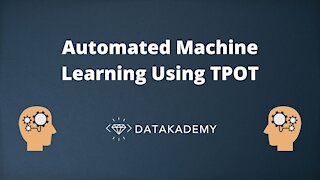Premium Only Content

The Dimpled Manifold Model of Adversarial Examples in Machine Learning (Research Paper Explained)
#adversarialexamples #dimpledmanifold #security
Adversarial Examples have long been a fascinating topic for many Machine Learning researchers. How can a tiny perturbation cause the neural network to change its output by so much? While many explanations have been proposed over the years, they all appear to fall short. This paper attempts to comprehensively explain the existence of adversarial examples by proposing a view of the classification landscape, which they call the Dimpled Manifold Model, which says that any classifier will adjust its decision boundary to align with the low-dimensional data manifold, and only slightly bend around the data. This potentially explains many phenomena around adversarial examples. Warning: In this video, I disagree. Remember that I'm not an authority, but simply give my own opinions.
OUTLINE:
0:00 - Intro & Overview
7:30 - The old mental image of Adversarial Examples
11:25 - The new Dimpled Manifold Hypothesis
22:55 - The Stretchy Feature Model
29:05 - Why do DNNs create Dimpled Manifolds?
38:30 - What can be explained with the new model?
1:00:40 - Experimental evidence for the Dimpled Manifold Model
1:10:25 - Is Goodfellow's claim debunked?
1:13:00 - Conclusion & Comments
Paper: https://arxiv.org/abs/2106.10151
My replication code: https://gist.github.com/yk/de8d987c4e...
Goodfellow's Talk: https://youtu.be/CIfsB_EYsVI?t=4280
Abstract:
The extreme fragility of deep neural networks when presented with tiny perturbations in their inputs was independently discovered by several research groups in 2013, but in spite of enormous effort these adversarial examples remained a baffling phenomenon with no clear explanation. In this paper we introduce a new conceptual framework (which we call the Dimpled Manifold Model) which provides a simple explanation for why adversarial examples exist, why their perturbations have such tiny norms, why these perturbations look like random noise, and why a network which was adversarially trained with incorrectly labeled images can still correctly classify test images. In the last part of the paper we describe the results of numerous experiments which strongly support this new model, and in particular our assertion that adversarial perturbations are roughly perpendicular to the low dimensional manifold which contains all the training examples.
Abstract: Adi Shamir, Odelia Melamed, Oriel BenShmuel
Links:
TabNine Code Completion (Referral): http://bit.ly/tabnine-yannick
YouTube: https://www.youtube.com/c/yannickilcher
Twitter: https://twitter.com/ykilcher
Discord: https://discord.gg/4H8xxDF
BitChute: https://www.bitchute.com/channel/yann...
Minds: https://www.minds.com/ykilcher
Parler: https://parler.com/profile/YannicKilcher
LinkedIn: https://www.linkedin.com/in/ykilcher
BiliBili: https://space.bilibili.com/1824646584
If you want to support me, the best thing to do is to share out the content :)
If you want to support me financially (completely optional and voluntary, but a lot of people have asked for this):
SubscribeStar: https://www.subscribestar.com/yannick...
Patreon: https://www.patreon.com/yannickilcher
Bitcoin (BTC): bc1q49lsw3q325tr58ygf8sudx2dqfguclvngvy2cq
Ethereum (ETH): 0x7ad3513E3B8f66799f507Aa7874b1B0eBC7F85e2
Litecoin (LTC): LQW2TRyKYetVC8WjFkhpPhtpbDM4Vw7r9m
Monero (XMR): 4ACL8AGrEo5hAir8A9CeVrW8pEauWvnp1WnSDZxW7tziCDLhZAGsgzhRQABDnFy8yuM9fWJDviJPHKRjV4FWt19CJZN9D4n
-
 6:38
6:38
Datakademy
3 years agoAutomated Machine Learning Using TPOT
84 -
 5:58
5:58
Datakademy
3 years agoAutomated Machine Learning Using Auto-Sklearn (Scikit-learn)
281 -
 23:34
23:34
Stephen Gardner
1 hour ago🔥CNN PANICS over $5000 DOGE Dividend | Trump Orders bigger Audits
12.2K51 -
 1:53:54
1:53:54
The White House
4 hours agoPresident Trump Holds a Press Conference with President Emmanuel Macron of France
28.2K23 -
 1:48:31
1:48:31
The Officer Tatum
4 hours agoLIVE MSNBC DROPS HAMMER On Joy Reid as STAFFERS PANIC! + More Ep 67
39.8K43 -
 59:36
59:36
Chad Prather
3 hours agoTRUMP TAPS DAN BONGINO TO HELP LEAD FBI - IT’S OVER FOR THE DEEP STATE!
38K24 -
 4:18:28
4:18:28
Barry Cunningham
9 hours agoTRUMP DAILY BRIEFING: DAN BONGINO TO FBI | LIVE PRESS CONFERENCE WITH MACRON | DOGE MELTDOWN!
37K11 -
 2:08:16
2:08:16
Mike Rowe
3 days agoTim Allen Loves The Ballet | The Way I Heard It with Mike Rowe
37.9K17 -
 1:42:25
1:42:25
Russell Brand
8 hours agoWar, Wokeism & Wealth: The Forces Reshaping Our World – SF542
124K83 -
 1:24:13
1:24:13
vivafrei
7 hours agoMadness in Ireland! The War on Women, Children and the Attempt to Silence Whistleblower Jana Lunden!
70.7K46